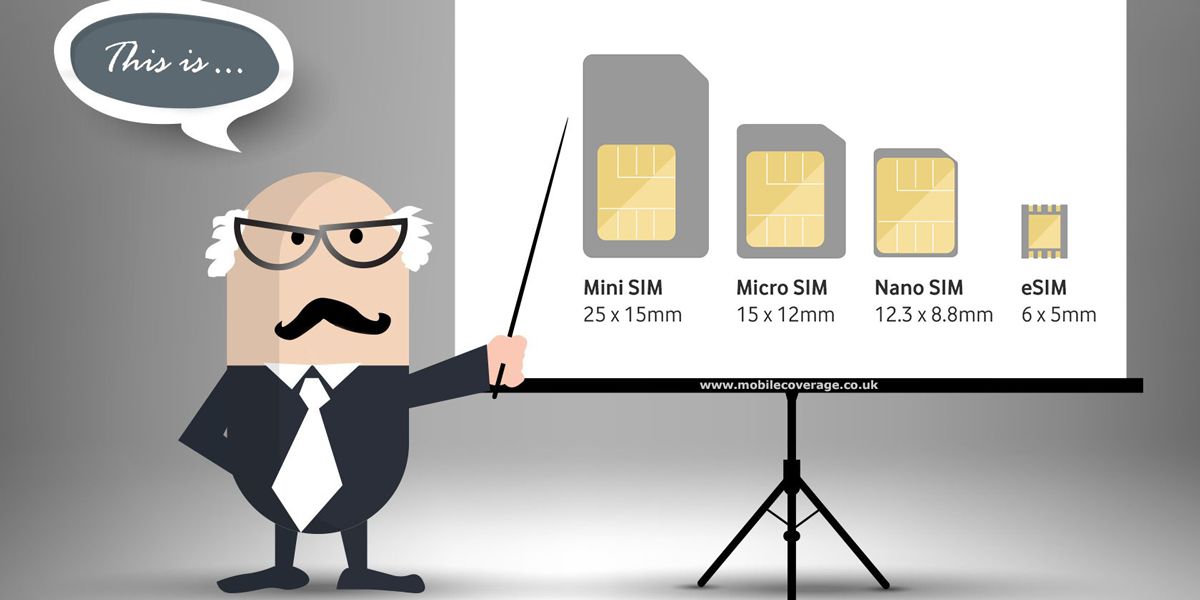SIM stands for Subscriber Identity Module or Subscriber Identification Module.
eSIM stands for embedded SIM – which means it is built into the mobile device.
Introduction to SIM cards
A SIM card is a small electronic chip that acts as a link between your mobile device and a network provider. It contains your network account information, such as telephone number, phonebook contacts, text messages, and other data that can be stored on the SIM card's memory chip.
When you insert a SIM card into a mobile device, it is able to connect to the network operator. This then allows you to access the mobile network provider and use their services, such as making and receiving phone calls, sending SMS text messages, and accessing the internet.
Physical SIM cards come in different sizes, either a Mini SIM, Micro SIM, or Nano SIM, depending on what size a particular mobile device can use.
Over the years, SIM cards have been shrinking in size to enable mobile devices to get smaller or provide more space for other components, like bigger batteries.
Introducing eSIM cards
Instead of having a physical SIM card that needs to be inserted into a tray or slot inside a mobile phone, an eSIM chip is embedded directly as part of a device's internal components.
eSIM cards are tiny chips that take up less space inside a device and are reprogrammable through software so that they can be changed without swapping them out.
This makes switching network providers easier and more secure with the use of eSIMs because they can be changed and updated wirelessly on the device over an internet connection.
Advantages of using eSIMs
Due to the small size of an eSIM, they take up much less space, especially when you factor in the lack of tray or slot that is needed for a physical SIM card. This allows them to be used on things like smartwatches and other wearable or small devices.
This also enables smartphones to be built smaller or have room for larger batteries or other circuit chips for additional features.
For smartphones and networks providers that support e-SIMs, switching mobile networks has never been easier and quicker because you do not have to order and wait for a physical SIM card to be delivered to you.
This is especially useful if you are travelling abroad or away from home and are unable to accept delivery of a new or replacement SIM card.
eSIMs are also more secure because you no longer need a separate SIM card, which can be easily lost or damaged when inserting or swapping them out.
Currently all mobile phones that include an e-SIM option also feature a regular physical SIM card slot, so you can use either or both at the same time, also known as a dual-SIM phone.
eSIMs themselves can also support multiple SIM cards on one chip, so you can have multiple mobile plans on one device at the same time.
This allows you, for example, to use use one smartphone for both personal and work, or use a local mobile plan while travelling abroad, or simply use separate voice and data plans on one device.
How to use an eSIM
You will need two things to take advantage of an eSIM card.
Firstly a mobile device that contains an eSIM that is built into it. Most new smartphones from Apple iPhone, Google Pixel, Samsung Galaxy, and other Android devices feature an embedded SIM and this will become more common as eSIMs get wider adoption.
Secondly a mobile network operator that provides eSIM support. Again this is quickly becoming a feature that is available and eventually all network providers will offer an eSIM option in addition to their existing physical SIM cards for those mobile devices that do not support eSIMs.
Activating or switching to an eSIM is done through a simple process of scanning a QR code or entering a code manually that is provided by the mobile network provider.
Once the eSIM is activated, you will then be able to use it just like a regular SIM card to make calls, send text messages, and connect to the internet.
While physical SIM cards won't be going away anytime soon, the eSIM is are fast becoming the standard SIM card of choice because of the many advantages they offer over traditional SIMs.
